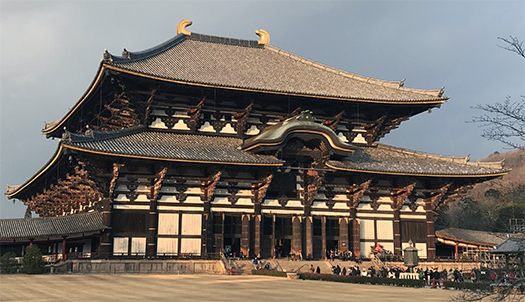

平安時代中期970年の書『口遊』(くちづさみ)には当代の建物の大きさ比べで
「雲太 和二 京三」とあり出雲の大社が一番、次いで大和東大寺の大仏殿、
3位が京都平安京の大極殿と注釈してある。
東大寺の大仏殿は当時高さ45mというように記載されている。
出雲大社は国譲りして退隠した前王朝が、その権威性を尊重せよと
いわば政治的譲渡約束に即して建築された神殿建築。
3位の大極殿は言うまでもなく国家の権力中心建築。
鎮護国家という統一国家の礎として導入した国際宗教への尊崇を高める目的が
そのまま建築の規模として民心に刷り込まれるような巨大木造。
752年が大仏開眼会だったから200数十年後でもこう評価されていたことになる。
現存する大仏殿は、正面の幅57.5m、奥行き50.5m、棟までの高さ49.1m。
奥行と高さは創建当時とほぼ同じだが、幅は創建当時(約86m)の約3分の2。
出雲にしても同様だけれど、創建の時代相を考えれば、
日本の木造建築技術の粋が集中したであろうことは明らかです。
この巨大木造建築ぶりをみれば、足場すらどうしたのと驚くばかり。
上の写真は正面の開口部を見上げたもの。
唐破風の屋根がせり出しているけれど、創建時はこれはなかった。
戦国期での焼失を経て江戸期1700年代に至って改修されたデザイン感覚。
開口部の扉の高さと人間の様子だけをみても度肝を抜く建築だとわかる。
こういうスケールの木造建築を日本社会は永く造営してきた。
先般触れたけれど出雲大社は、これよりもさらに巨大であったとされる。
「奈良の大仏が見たい」と小学校時代の息子に言われたことがあるけれど、
日本人の建築体験にとってこの大仏殿は永く特別だった。
なじみ深い建築様式である木造工法で
目を剥く巨大建築を作ることが単純に国家の威信を表現した。
やはり「大きいことはいいこと」なんですね。
民族的アイデンティティの形成の部分にまで深く関わっている。
奈良時代に確立した統一国家形成にとっていかに重要なアイコンだったか、
この建築は日本民族とともに存続して行くに違いない。
しかしそうした権力との深い関わりから、幾たびも戦火焼失も生起した。
宗教施設、とくに寺院の場合は一種の「城郭」としての機能性もあるので
内戦時には恰好の攻防施設としても利用されるのでしょう。
繰り返された戦争で京都が何度も焼失を繰り返したと同じ事情で
奈良の大仏殿もそういう運命から逃れられなかった。
English version⬇
[45m Super Great Buddha Hall, “Unta Kazuji Kyozo” Todaiji Temple Review-3]
In the book “Kuchiyu” (Kuchizusami) in the middle of the Heian period in 970, compared to the size of the building of the present generation.
There is “Unta Kazuji Kyozo” and the Izumo Taisha Shrine is the first, followed by the Great Buddha Hall at Yamato Todaiji Temple.
The third place is annotated as Daigokuden in Heiankyo, Kyoto.
The Great Buddha Hall at Todaiji Temple is described as having a height of 45m at that time.
Izumo Taisha said that the former dynasty, which had retired from the country, should respect its authority
So to speak, temple architecture built in line with political promises.
Needless to say, the 3rd place Daigokuden is a power-centered building of the nation.
To increase the reverence for the international religion introduced as the foundation of the unified nation of the guardian nation
A huge wooden structure that imprints on the people’s heart as it is as the scale of the building.
Since 752 was the opening of the Great Buddha, it would have been evaluated as such even 200 decades later.
The existing Great Buddha Hall has a front width of 57.5m, a depth of 50.5m, and a height of 49.1m to the ridge.
The depth and height are almost the same as when it was built, but the width is about two-thirds of when it was built (about 86m).
Considering the era of its founding, Izumo is the same, but
It is clear that the best of Japanese wooden construction technology would have been concentrated.
Looking at this huge wooden building, I was wondering what happened to the scaffolding.
The photo above is a look up at the front opening.
The Karahafu roof is protruding, but it seems that this was not the case when it was first built.
A sense of design that was renovated from the burning in the Warring States period to the 1700s in the Edo period.
Even if you look only at the height of the door at the opening and the appearance of human beings, you can see that the architecture is amazing.
Japanese society has built wooden buildings of this scale.
Izumo Taisha was mentioned earlier, but it is said that it was even bigger than this.
I was once told by a child in elementary school that I wanted to see the Great Buddha of Nara.
This Great Buddha Hall may have been special for the Japanese architectural experience.
With the wooden construction method, which is a simple and familiar architectural style
The prestige of the nation was expressed by creating a huge building that was eye-opening.
After all, “big is good”, isn’t it?
It is deeply involved in the formation of ethnic identity.
How important it was for the formation of a unified nation established in the Nara period
This architecture must survive for a long time.
However, due to his deep connection with such power, he was repeatedly burned down in the war.
In the case of religious facilities, especially temples, it also functions as a kind of “castle”.
It will also be used as a good defensive facility during the civil war.
Under the same circumstances as Kyoto was repeatedly burned down in repeated wars
The Great Buddha Hall in Nara could not escape from such a fate.
Posted on 9月 29th, 2021 by 三木 奎吾
Filed under: 住宅マーケティング, 日本社会・文化研究







コメントを投稿
「※誹謗中傷や、悪意のある書き込み、営利目的などのコメントを防ぐために、投稿された全てのコメントは一時的に保留されますのでご了承ください。」
You must be logged in to post a comment.